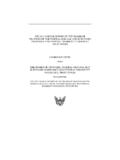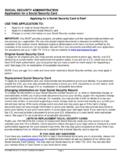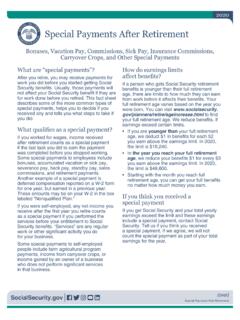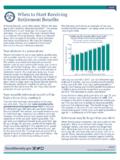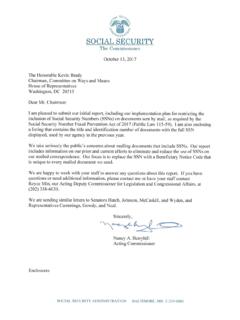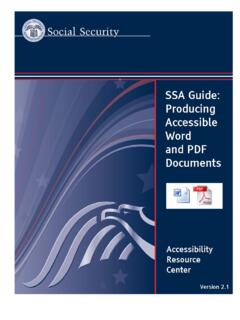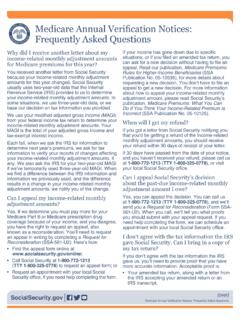Transcription of Agreement Between The United States And Canada
1 (over) Agreement Between The United States And CanadaAgreement Between The United States And CanadaContentsIntroduction 1 Coverage and social security taxes 2 Certificate of coverage 4 Monthly benefits 5A CPP/QPP pension may affect your benefit 10 What you need to know about Medicare 10 Claims for benefits 10 Authority to collect information for a certificate of coverage (see pages 4-5) 11 Contacting social security 12 IntroductionAn Agreement effective August 1, 1984, Between the United States and Canada improves social security protection for people who work or have worked in both countries. It also helps protect the benefit rights of people who have earned Canadian social security credits based on residence and/or contributions in the Canadian social security system includes a special pension plan operated in the Province of Quebec, an additional understanding has been concluded with Quebec to extend the Agreement to that province also effective August 1, 1984.
2 Terms of the Agreement and the understanding are very similar, and except where otherwise noted, references in this booklet to the Agreement also apply to the Agreement with Canada helps many people who, without the Agreement , would not be eligible for monthly retirement, disability or survivors benefits under the social security system of one or both countries. It also helps people who would otherwise have to pay social security taxes to both countries on the same the United States , the Agreement covers social security taxes (including the Medicare portion) and social security retirement, disability and survivors insurance benefits. It does not cover benefits under the Medicare program or the Supplemental (over) Agreement Between The United States And CanadaSecurity Income program. For Canada , the Agreement applies to the Old-Age security program and the Canada Pension Plan.
3 The understanding with Quebec applies to the Quebec Pension Plan. This booklet covers highlights of the Agreement and explains how it may help you while you work and when you apply for Agreement may help you, your family and your employer While you work If your work is covered by both the and Canadian social security systems, you (and your employer, if you are employed) would normally have to pay social security taxes to both countries for the same work. However, the Agreement eliminates this double coverage so you pay taxes to only one system (see pages 2-5). When you apply for benefits You may have some social security credits in both the United States and Canada but not have enough to be eligible for benefits in one country or the other. The Agreement makes it easier to qualify for benefits by letting you add together your social security credits in both countries.
4 For more details, see the section on Monthly benefits beginning on page and social security taxesBefore the Agreement , employees, employers and self-employed people could, under certain circumstances, be required to pay social security taxes to both the United States and Canada for the same the Agreement , if you work as an employee in the United States , you normally will be covered by the United States , and you and your employer will pay social security taxes only to the United States . If you work as an employee in Canada , you normally will be covered by Canada , and you and your employer pay social security taxes (contributions) only to the other hand, if your employer sends you from one country to work for that employer or an affiliate in the other country for five years or less, you will continue to be covered by your home country and you will be exempt from coverage in the other country.
5 For example, if a company sends an employee to work for that employer or an affiliate in Canada for no more than five years, the employer and the employee will continue to pay only social security taxes and will not have to pay in Canada . Even if your occupation (such as truck driver or professional athlete) requires you to make frequent short trips from one country to the other over a period of more than five years, each trip can be considered separately so that you remain covered only by the country from which you are you are self-employed and reside in the United States or Canada , you generally will be covered and taxed only by the country where you of Agreement rulesThe following table shows whether your work is covered under the or Canadian social security system. If you are covered under social security , you and your employer (if you are an employee) must pay social security taxes.
6 If you are covered under the Canadian system, you and your employer (if you are an employee) must pay Canadian social security taxes (contributions). The next section explains how to get a form from the country where you are covered that will prove you are exempt in the other (over) Agreement Between The United States And CanadaYour work statusCoverage and taxesYou are working in Canada /Quebec:For a employer who:Sent you to work in Canada /Quebec for five years or less you to work in Canada /Quebec for more than five yearsCanada/QuebecHired you in Canada /QuebecCanada/Quebec For a employerCanada/Quebec For governmentWrite to the address on page 12 for further are working in the United States :For an employer in Canada /Quebec who:Sent you to work in the United States for five years or lessCanada/Quebec Sent you to work in the United States for more than five you in the United a non-Canadian/Quebec For the Canadian/Quebec governmentWrite to the appropriate Canadian address on page 12 for further are self-employed and you:Reside in the United in Canada /QuebecCanada/Quebec If this table does not seem to describe your situation and you are:Working in the United StatesWrite to the address on page 12 for further in Canada /QuebecWrite to the appropriate Canadian address on page 12 for further : As the table indicates, a worker employed in Canada can be covered by social security only if he or she works for a employer.
7 A employer includes a corporation organized under the laws of the United States or any state, a partnership if at least two thirds of the partners are residents, a person who is a resident of the United States or a trust if all the trustees are residents. The term also includes a foreign affiliate of a employer if the employer has entered into an Agreement with the Internal Revenue Service (IRS) under section 3121(l) of the Internal Revenue Code to pay social security taxes for citizens and residents employed by the (over) Agreement Between The United States And CanadaCertificate of coverageA certificate of coverage issued by one country serves as proof of exemption from social security taxes on the same earnings in the other country. Generally, you will need a certificate only if you will be working in the other country for more than 183 days in a calendar year.
8 If you will be in the other country for 183 days or less, a certificate will not be needed unless the other country requests that you get for employeesTo establish an exemption from compulsory coverage and taxes under the Canadian system, your employer must request a certificate of coverage (form USA/CAN 101 or USA/QUE 101) from the United States at this address: social security AdministrationOffice of International Box 17741 Baltimore, MD 21235-7741 USAIf preferred, the request may be sent by FAX to (410) 966-1861. Please note this FAX number should only be used to request certificates of coverage. No special form is required to request a certificate but the request must be in writing and provide the following information: Full name of worker; Date and place of birth; Citizenship; Country of worker s permanent residence; social security number; Date of hire; Country of hire; Name and address of the employer in the and Canada ; and Date of transfer and anticipated date of addition, your employer must indicate if you remain an employee of the company while working in Canada or if you become an employee of the company s affiliate in Canada .
9 If you become an employee of an affiliate, your employer must indicate if the company has an Agreement with the IRS under section 3121(l) of the Internal Revenue Code to pay social security taxes for citizens and residents employed by the affiliate and, if yes, the effective date of the Agreement . Your employer can also request a certificate of coverage for you over the Internet using a special online request form available at Only an employer can use the online form to request a certificate of coverage. A self-employed person must submit a request by mail or establish your exemption from coverage under the social security system, your employer in Canada must request a certificate of coverage from Canada as follows: If your work will remain covered by the Canada Pension Plan, request a certificate (form CPT56A) from:CPP/EI Rulings Department Ottawa Tax Services OfficeCanada Revenue Agency Section333 Laurier Avenue WestOttawa, OntarioCANADA K1A 0L9 If your work will remain covered by the Quebec Pension Plan, request a certificate (form QUE/USA 101) from.
10 Bureau des ententes de s curit socialeR gie des rentes du Qu bec1055, Ren -L vesque Est, 13e tageMontr al, Qu becCANADA H2L 4S5 The same information required for a certificate of coverage from the United States is needed to get a certificate from Canada or Quebec 5(over) Agreement Between The United States And Canadaexcept that you must show your Canadian social insurance number rather than your social security for self-employed peopleIf you are self-employed and would normally have to pay social security taxes to both the and Canadian systems, you can establish your exemption from one of the taxes. If you reside in the United States , write to the social security Administration at the address on page 4; or fax to (410) 966-1861; or If you reside in Canada , write to the appropriate Canadian address on page sure to provide the following information in your letter: Full name; Date and place of birth; Citizenship; Country of permanent residence; and/or Canadian social security number; Nature of self-employment activity; Dates the activity was or will be performed; and Name and address of your trade or business in both date of coverage exemptionThe certificate of coverage you receive from one country will show the effective date of your exemption from paying social security taxes in the other country.
